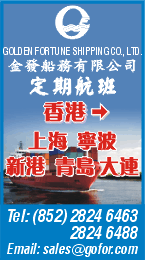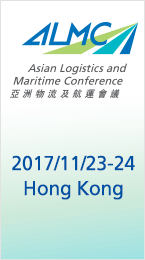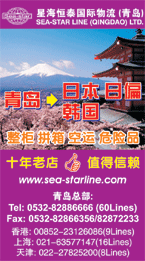|
Today's e-news sponsored by :
|
|
Powered by HKSG GROUP
|
|

|
|

|
|
The Leading Maritime & Transport News Portal
|
Thursday, November 23, 2017
|

(Click on the above banner to know more)
|
|
|
|
|
|
|
|
OOCL takes delivery of fifth 21,413TEU boxship, the OOCL Scandinavia
HONG Kong's Orient Overseas Container Line (OOCL) has taken delivery of its fifth 21,413 TEU boxship in a series of six 'G Class' containerships from Samsung Heavy Industry (SHI) shipyard.
The vessel, in the shipping liner's fleet of world trade ambassadors, has been named the OOCL Scandinavia that will be joining her sister vessels on its LL1 service, linking major markets in China and Northern Europe together.
At a ceremony to christen the vessel, OOCL chairman, C C Tung, said : "The One Belt One Road initiative comes at a very important time in the shipping industry where leadership and policy directions to stimulate demand growth is needed most. We are in a very capital intensive business, and like the Belt and Road initiative, we cannot do it alone."
Mr Tung thanked SHI for their dedication and support to OOCL over the years to consistently build vessels of the highest quality.
"The incredible work that has gone into the construction of this massive containership before us is the perfect embodiment of what teamwork means and how business collaboration can achieve wonders," said Mr Tung. "This achievement is about working to bring people and companies of different professions and nationalities together to reach new heights, innovate, solve complicated engineering problems, and along the way, why not break a world record too!"
The OOCL Scandinavia will be joining her sister vessels the OOCL Hong Kong, OOCL Germany, OOCL Japan and OOCL United Kingdom in serving the Asia-Europe trade lane on the LL1 service and her port rotation is: Shanghai, Ningbo, Xiamen, Yantian, Singapore, via Suez Canal, Felixstowe, Rotterdam, Gdansk, Wilhelmshaven, Felixstowe, via Suez Canal, Singapore, Yantian and then returning to Shanghai in a 77-day round trip.

|
|
Ocean carriers fared better financially in Q3 over 2016-Q3, except HMM
THE third quarter of 2017 has seen marked improvements in the financial results of shipping liners compared to the same period last year.
SeaIntel Maritime Analysis said ten of the eleven carriers that published their Q3 results recorded a positive EBIT/operating profit, with only Hyundai Merchant Marine (HMM) in the red.
In 2016-Q3 only Hapag Lloyd and Wan Hai reported positive figures of US$72 million and $10 million, respectively. In 2017-Q3 however, all the carriers except for HMM have posted positive quarterly operating results.
Danish shipping giant, Maersk Line, which reported the biggest year-on-year EBIT loss of $456 million in 2016-Q3, has made the biggest recovery with a positive EBIT of $263 million in 2017-Q3, which is also the largest y-o-y change of $416 million in 2017-Q3.
China's Cosco also made a strong recovery, turning an operating loss of $244 million in 2016-Q3 into an operating profit of $15 million in 2017-Q3.
HMM, which is the only carrier to record an operating loss of $26 million has now recorded operating losses in each of the last four third quarters (including this one). However, HMM have reduced their losses by almost $170 million year on year 2017-Q3, from an operating loss of $195 million in 2016-Q3.
Hapag Lloyd is the only carrier presenting positive operating results in third quarters of all 8 years from 2010 to 2017. MOL, which posted an operating loss in every third quarter since 2011, recorded an operating profit in 2017-Q3, of $19 million for a y-o-y change of $112 million.
Talking about the less than stellar 2017-Q3 results, SeaIntel CEO, Alan Murphy said: "While 2017-Q3 freight rates certainly were an improvement over the horrendous 2016-Q3 peak season, the improvement is just marginal, and we are still significantly below the 2011-2014 period, and just barely at the level seen in 2015.
"As we have detailed in our analysis in recent weeks, the soft freight rates have been driven by low peak season utilisation levels, as carriers have almost completely avoided blanking sailings in 2017. This in essence explains why 2017-Q3 operational returns severely underperformed carrier expectations, despite the healthy 2017-Q3 demand growth."

|
|
Maersk urges shipping industry to ramp up efforts to cut CO2 emissions
MAERSK is calling for a concerted effort from the shipping industry to lower carbon dioxide emissions and step up measures to pollute less.
"Raising the ambition for global regulation remains crucial to ensure shipping's contribution to reach the Paris Agreement's goal of staying below two degrees Celsius temperature rise," Maersk head of sustainability strategy John Kornerup Bang wrote in a letter released recently.
Over the next three decades, shipping's share of the world's CO2 output is expected to swell to 15 per cent, up from its current level of two per cent, according to the UCL Energy Institute and the Danish Shipowner's Association, reported The Maritime Executive of Fort Lauderdale.
Like others in the industry, Mr Bang noted that much more innovation will be required before shipping can do without fossil fuel altogether.
However, he pointed out that the International Maritime Organization (IMO) has already identified existing technology to lower the sector's emissions by 75 per cent.
Maersk has often been at the head of the pack on energy efficiency, and it was an early adopter of ultra large container ships, slow steaming and bulbous bow replacements. Overall, Maersk Line has cut its CO2 emissions per TEU by 40 per cent over the last ten years, and Mr Bang said that it is aiming to take this to 60 per cent by 2020.
However, he stressed that the world's shipping line can't do it alone. The solution, he suggests, is regulatory guidance that would level the global playing field.
In particular, he said that Maersk was disappointed that shipping was not included in the COP21 treaty in 2015; the sector was left out of the landmark climate agreement following lobbying by IMO, which argued that shipping's CO2 should be regulated through the traditional convention and ratification process.
Over the years since, IMO's member states have not yet settled on specific regulations, though they have agreed to a fuel consumption monitoring programme. Mr Bang said that the pressure is on for IMO to act, and "we would have preferred to see more progress during [the latest meeting] in October this year, particularly on the level of ambition."
He expressed hope that IMO will reach an agreement with concrete measures at the Marine Environment Protection Committee (MEPC) meeting next year.

|
|
Port of Long Beach gets US$2.4m government pollution reduction grant
THE US Environmental Protection Agency has awarded the Port of Long Beach (POLB) with a US$2.4 million grant to help three of its tenants replace equipment with zero-emission or cleanest-available equipment.
The Diesel Emission Reduction Act funds go to aid for port tenants Stevedoring Services of America (SSA), Foss Maritime and Curtin Maritime, the port said. It will enable SSA to retrofit three rubber-tired gantry cranes to all-electric operations, entirely reducing related emissions and diesel fuel consumption.
The grant will also assist in the retrofitting of four tugboats operated by Foss and Curtin with the newest and cleanest engines available, reports American Shipper.
The projects are expected to reduce carbon dioxide by 15,606 tonnes over the next two decades according to the port, plus cut nitrogen oxide by 1,649 tonnes, carbon monoxide by 267 tonnes, diesel particulate matter by 61 tonnes and hydrocarbons by 40 tonnes.
The equipment is scheduled to be in place by the end of 2019.
POLB Harbour Commission president Lou Anne Bynum said in a statement: "We thank the EPA for providing funds to facilitate these projects and improve the health of our community. Every step we take to cut air pollution is one toward our ultimate goal of being the world's first zero-emission seaport."

|
|
US agriculture exports reach US$140.5b in FY 2017
THE United States exported a total of US$140.5 billion worth of agricultural exports for fiscal year 2017, ending September 30, an increase of $10.9 billion over the previous fiscal year, according to recent data from the US Department of Agriculture (USDA).
China was the largest export market for US agricultural goods, totalling $22 billion, USDA said. Canada was the second largest US export market at $20.4 billion, while Mexico imported $18.6 billion worth of US agricultural goods. Japan was the fourth largest export market at $11.8 billion. The remainder of the top 10 overseas markets for US agricultural goods include the European Union ($11.6 billion), South Korea ($6.9 billion), Hong Kong ($4 billion), Taiwan ($3.4 billion), Indonesia ($3 billion) and the Philippines ($2.6 billion).
US bulk commodity exports overall set a volume record at 159 million metric tonnes, up 11 per cent from fiscal year 2016, with a value of $51.4 billion, according to USDA figures. Soybeans was the top US bulk agricultural export at 60 million metric tonnes, with a value $24 billion. The value of cotton exports increased 70 per cent to $5.9 billion, while wheat exports rose 21 per cent to $6.2 billion and corn exports bumped up 6 per cent to $9.7 billion.
Meanwhile, US dairy exports during fiscal year 2017 grew 17 per cent to $5.3 billion, beef exports were up 16 per cent to $7.1 billion, and pork exports increased 14 per cent to $6.4 billion, according to American Shipper.

|
|
Brazil's Santos port badly hit by 4-week old customs strike
SOUTH America's largest port, Santos of Brazil, has been hardest hit with containers delayed between five days and a week due to strike action by the nation's Receita Federal (customs), which has intensified as it enters its fourth week.
The strike is also causing severe delays to carriers with containers missing their sailings and racking up detention and demurrage fees, according to the Sao Paulo and Santos Shipagents Association (Sindamar) and other sources in the port city, IHS Media reported.
"All Santos customs officials are on strike and the damage is incalculable," Jose Roque, the executive president for Sindamar said. "We must find a solution to this impasse and sooner rather than later."
Adding to the trouble, officials in the tax analysts section of the Receita Federal have joined the strike and delays are also mounting at key border crossings, particularly along the borders with Argentina and Paraguay.
Mr Roque and Sindamar have been pushing for a resolution to the crisis, sending several letters to the Ministers of Planning and Finance in Brasilia and union leaders over the past week, asking all involved to make concessions "for the sake of the country".
"Loads that are normally cleared in 24 hours accumulate in the terminals waiting for authorisations," said Mr Roque. "If this situation persists, terminals are expected to exhaust their physical capacity for storage shortly and all their spaces will be occupied due to lack of clearance, with ships leaving Santos without all scheduled loads, resulting in loss of revenue from maritime freight."
Coffee and beef shippers are among those most badly affected. with one coffee exporter saying that his company was suffering delays of two or three days after eight days of strike action, but those delays have now grown to between five and seven days.
"October and November are usually the key export months for us, and this year we are suffering a nightmare with these long delays through Santos," the exporter said.
Many transshipment connections in Santos have been broken, spreading the pain well beyond Brazil, Mr Roque said. "The strike is all over Brazil and is also especially severe on our borders."
The National Union of Tax Auditors (Sindifisco) says that the strike at Santos alone costs the government BRL100 million (US$30.6 million) daily and the union estimates that this round of strike action has cost the treasury BRL1.5 billion. However, the government is holding firm, and seems unwilling to grant the customs officers' demands as it works to improve the country's finances.

|
|
Dredging of Bangaldesh's Mongla port to ease congestion at Chittagong
SHIPS with drafts of 10.5 metres will be able to berth at Mongla port in Bangladesh once the dredging of its port channel is completed. The deepening of the channel is intended to turn the port into an alternative option for shippers who had to contend with severe congestion at Chittagong port this summer.
Mongla port is currently underutilised because it can only serve vessels with drafts of 8.5 metres. Shippers claim they must wait weeks to get goods to Mongla, reported IHS Media.
"Until now, small vessels can come to Mongla port due to its low draft. If big vessels call the port in increased numbers, Mongla will be able to cater external trade as an alternative to [the] congested Chittagong port," electronic goods importer Alamgir Hossen said.
The US$85.1 million dredging work will turn Mongla port into an attractive gateway because construction of the Padma bridge and a rail link will connect Mongla to the capital Dhaka, where most of Bangladesh's garment manufacturing capacity is located, Mr Hossen said.
Mongla port chairman Commodore AKM Faruque Hassan was quoted as saying: "We are raising capacity. We are buying equipment, and we are constructing two more jetties. Work will start by early next year."

|
|
Smugglers take sea route to bring gold into India
INDIA's directorate of revenue intelligence (DRI) has recently discovered that gold smugglers have begun using the sea route for illegally bringing the precious metal into the country. The authorities unearthed this method of smuggling while looking into the case of a citybased entity that allegedly smuggled gold through a ship's container.
Other entities have also been smuggling gold under the guise of machinery imports recently, the Economic Times of India reported.
"Container ships are being used for smuggling gold into the country and it's also being hidden inside machinery and smuggled in," a senior DRI official said. "These are part of the modus operandi in use in recent times."
DRI officials say that gold is being smuggled in not just from Dubai, Thailand, Hong Kong, Singapore, but also from the UK and the US more recently.
"In the case of machinery being shipped in by air cargo through London, we gathered that the modus operandi was used 35 times in the past before officials got a tip-off."
Smuggling commenced in 2013 after the government raised gold import duty from 2 per cent to 10 per cent in stages to contain a ballooning current account deficit and a falling rupee. Market sources said the DRI has been actively pursuing cases against those apprehended by it, as well as keeping a close vigil on suspicious cargo at air- and sea ports.

|
|
Boeing, boeing, gone! Jade Cargo's 2 B747Fs sold online to SF Express
CHINA's biggest private courier SF Express has purchased two Boeing 747-400 freighters, previously part of insolvent Chinese carrier Jade Cargo's fleet, on the Alibaba-owned auction website, Taobao.
The two airfreighters were sold for CNY160.8 million (US$24 million) and CNY162 million. The opening bid prices stood at CNY133.8 million and CNY135 million, London's Air Cargo News reported citing Hong Kong's South China Morning Post.
The report said the aircraft were owned by a state court, which took possession of the B747s after Jade Cargo filed for bankruptcy in 2013. Another aircraft owned by the court went unsold and remains at Shenzhen Baon International Airport.
There have been six previous attempts to sell the aircraft online when they were first put up for sale at an asking combined price of CNY1.3 billion.
While they are fairly good aircraft, the amount of time they have been out of action means they could need a fairly extensive and costly overhaul.
SF Express has been busy expanding its fleet over the last few years. In August, its airline arm added its 40th freighter to its fleet, which includes five B767s, 18 B757s and 17 B737s.
In May, the airline announced plans for a tie-up with UPS to develop international delivery services between China and the US.

|
|
E-commerce drives up air cargo demand, leading to tight space, higher rates
DEMAND for air cargo is being propelled by cross-border e-commerce and high levels of emergency shipments, leaving shippers scrambling for space on aircraft and paying higher freight rates as strong volume in Asia-Europe and Asia-North America trades quickly fills up available capacity.
Airfreight prices from Shanghai to Frankfurt in the past two months have doubled, according to data from eBooking and air freight automation platform Freightos WebCargo. In September, the rate was US$2.5 per kilogramme, rising to $3.7 per kilogramme in October and $5 per kilogramme in November, reported IHS Media.
"Driven by strong e-commerce sales and the buildup for holiday season, air capacity is stretched incredibly thin," said Freightos WebCargo CEO Manel Galindo. "The spot market is being heavily impacted by early capacity reservations by forwarders, as well as product launches such as Apple"s iPhoneX release."
Atlas Air Worldwide Holdings senior vice president Greg Guillaume agreed that the underlying reason for rising demand was e-commerce. "Over the longer term, e-commerce will account for an increasing share of retail sales - the mega-trend of our times," he said.
"Particularly in developed economies, we are seeing that e-commerce often uses express air freight as a mode of delivery to the customer. With the anticipated future expansion of e-commerce in emerging economies, its effect on air freight will drive growth for many years to come," said Mr Guillaume.
Retail e-commerce sales globally are forecast to total $2.29 trillion in 2017 and will rise to $4.48 trillion by the end of 2021, which would represent 16.1 per cent of total retail sales. Consumers in China will generate half of all worldwide e-commerce sales in 2017, according to research consultant eMarketer.

|
|
DHL Express to raise US rates by 4.9pc from January 2018
DHL Express has announced that rates for US account holders will be bumped up by 4.9 per cent on average, commencing from January 2018.
The company stated that it "adjusts its prices annually, taking into account inflation, currency dynamics and other rising costs, such as expenses related to compliance with enhanced security regulations, in each of the more than 220 countries and territories that it serves," reported American Shipper.
Last year, the parcel carrier raised rates by an average of 3.9 per cent in Germany and 4.9 per cent in the US.
Other carriers have implemented similar rate hikes for the holiday season, such as UPS introducing a new peak shipping charge during selected weeks in November and December 2017 for US residential, large packages and packages over maximum limits.

|
|
|
|
|

|
Copyright 2016 HKSG Group Media Ltd. All rights reserved.
|












